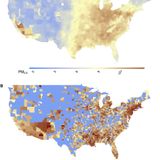RECENT ARTICLES

Air pollution and COVID-19 mortality in the United States: Strengths and limitations of an ecological regression analysis
Assessing whether long-term exposure to air pollution increases the severity of COVID-19 health outcomes, including death, is an important public health objective. Limitations in COVID-19 data availability and quality remain obstacles to conducting conclusive studies on this topic. At present, publicly available COVID-19 outcome data for representative populations are available only as area-level counts. Therefore, studies of long-term exposure to air pollution and COVID-19 outcomes using these data must use an ecological regression analysis, which precludes controlling for individual-level...…Assessing whether long-term exposure to air pollution increases the severity of COVID-19 health outcomes, including death, is an important public health objective. Limitations in COVID-19 data availability and quality remain obstacles to conducting conclusive studies on this topic. At present, publicly available COVID-19 outcome data for representative populations are available only as area-level counts. Therefore, studies of long-term exposure to air pollution and COVID-19 outcomes using these data must use an ecological regression analysis, which precludes controlling for individual-level...WW…

Evaluating the impact of long-term exposure to fine particulate matter on mortality among the elderly
Many studies link long-term fine particle (PM2.5) exposure to mortality, even at levels below current US air quality standards (12 μg/m3). These findings have been disputed, with claims that the use of traditional statistical approaches does not guarantee evidence of causality. Leveraging 16 years of data—68.5 million Medicare enrollees and 570 million observations—we provide strong evidence of the causal link between long-term PM2.5 exposure and mortality under a set of assumptions necessary for causal inference. Using five distinct statistical approaches, we found that a decrease of 10...…Many studies link long-term fine particle (PM2.5) exposure to mortality, even at levels below current US air quality standards (12 μg/m3). These findings have been disputed, with claims that the use of traditional statistical approaches does not guarantee evidence of causality. Leveraging 16 years of data—68.5 million Medicare enrollees and 570 million observations—we provide strong evidence of the causal link between long-term PM2.5 exposure and mortality under a set of assumptions necessary for causal inference. Using five distinct statistical approaches, we found that a decrease of 10...WW…
- Total 2 items
- 1